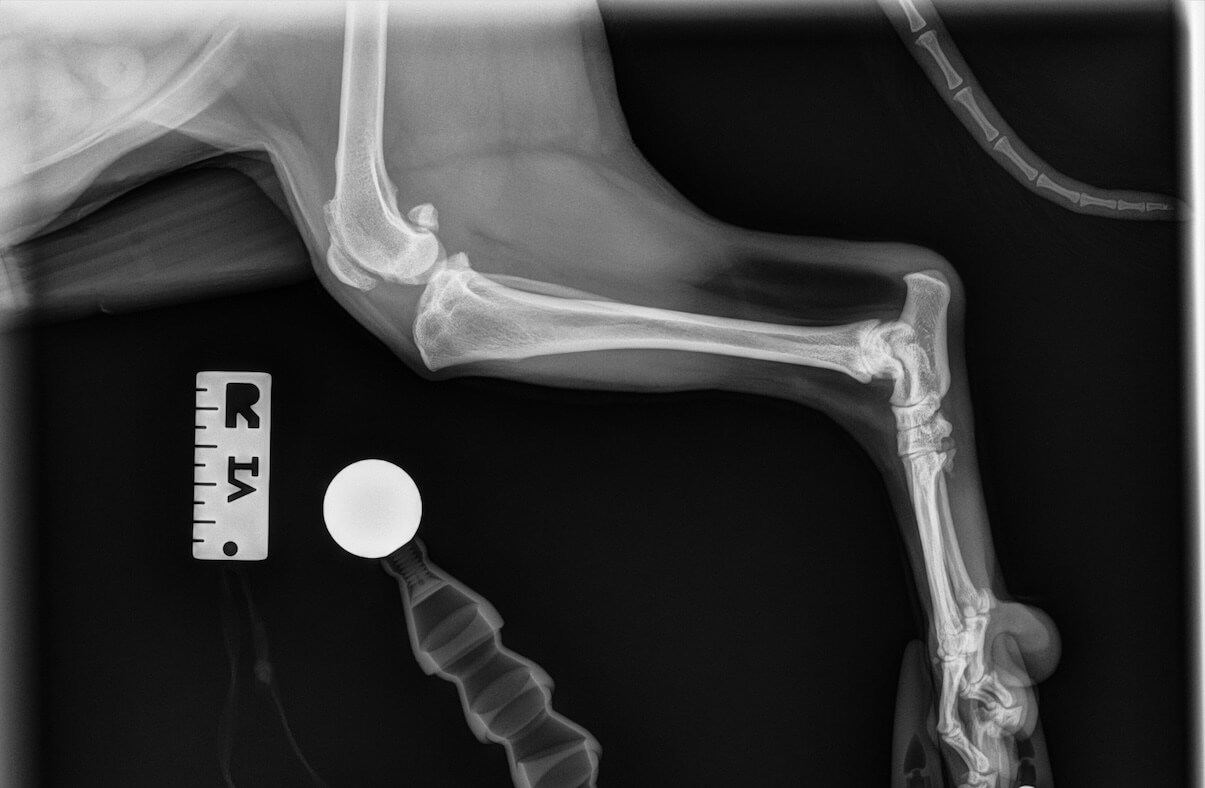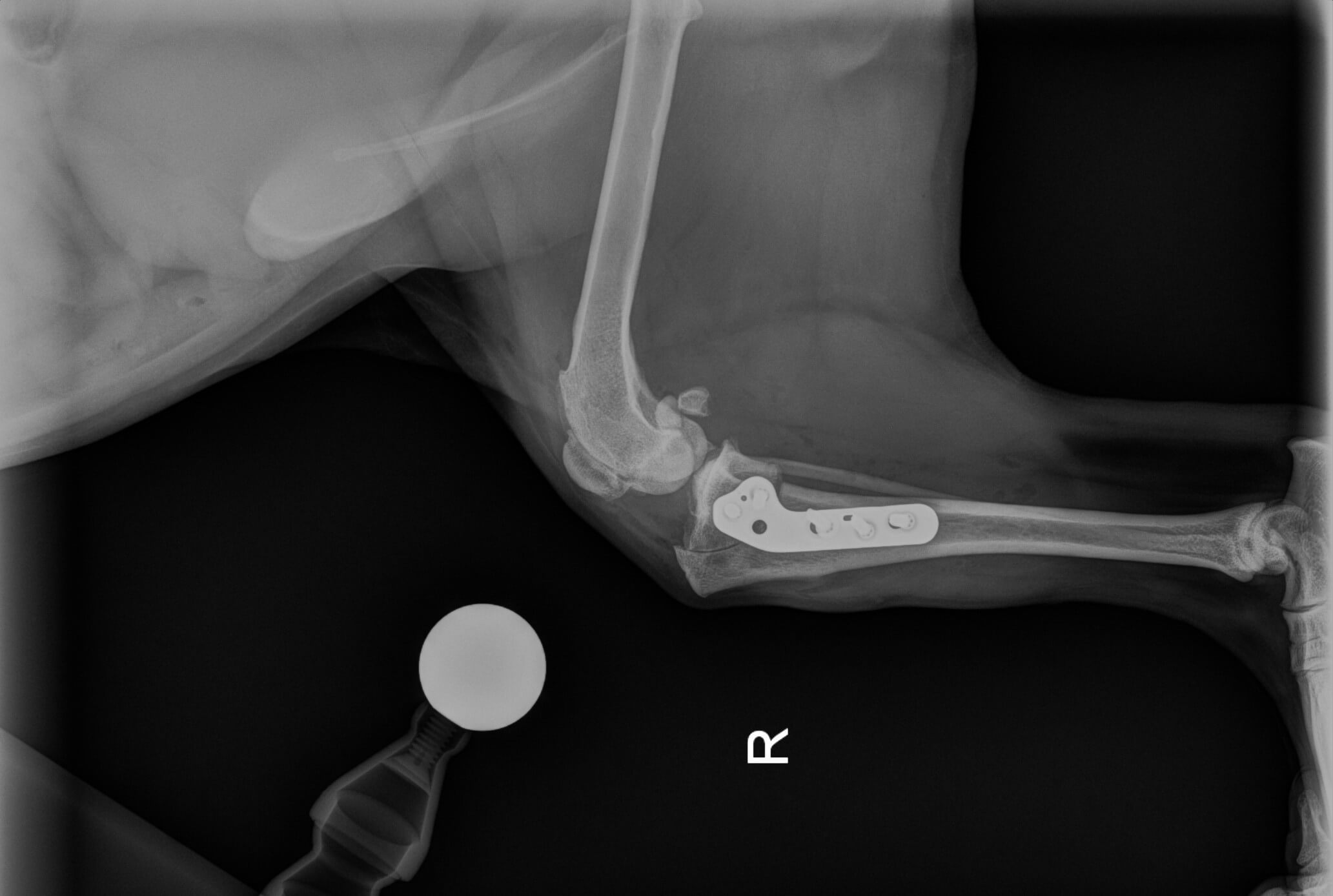The TPLO (Tibial Plateau Leveling Osteotomy) is the technique that reconstructs the angle of the stifle, to provide the most stable repair for a torn cranial cruciate ligament (CCL) available. A plate is used to stabilize the redirected angle of the knee which allows the patients to walk almost immediately on the repair, protecting the other leg from injury due to compensated weight-bearing (many dogs who injure one leg will tear the ligament in the second leg). Active dogs, older dogs, larger dogs, and even smaller dogs are the best patients for this procedure.
Cranial Cruciate Ligament Rupture (CCL)
A Cranial Cruciate Ligament tear is the most common cause of acute rear lameness in the dog. In humans, this ligament is known as the anterior cruciate ligament (ACL). Rupture of the CCL in an otherwise healthy joint is usually caused by some traumatic event or it could be the result of gradual weakening of the ligament. When the CCL is ruptured, instability of the stifle will cause the dog to become non-weight bearing on that leg because the tibia slides forward when they walk. This instability is often referred to as tibial thrust or “drawer” movement.
Diagnosis
 Dogs usually present with clinical signs such as a chronic limp, toe-touching on rear leg, or suddenly non-weight bearing. To accurately diagnose a torn CCL, our veterinarians perform a sedated orthopedic exam so that the muscles and ligaments are fully relaxed. This includes palpating the knee to feel for the drawer motion as well as other ligament changes and radiographs. Although the ligament cannot be seen in the x-rays a change in the angle of the joint can indicate a torn cruciate ligament.
Dogs usually present with clinical signs such as a chronic limp, toe-touching on rear leg, or suddenly non-weight bearing. To accurately diagnose a torn CCL, our veterinarians perform a sedated orthopedic exam so that the muscles and ligaments are fully relaxed. This includes palpating the knee to feel for the drawer motion as well as other ligament changes and radiographs. Although the ligament cannot be seen in the x-rays a change in the angle of the joint can indicate a torn cruciate ligament.
Prognosis and Recovery
 TPLOs are being reported across the country as having a faster recovery and decreased development of osteoarthritis. This procedure also will allow for a normal return to athletic or working activity! Recovery usually involves strict cage rest for a few weeks after surgery. Two weeks after surgery our veterinary staff wants to see the dog back for a drop off appointment. At this appointment sedated x-rays to check the plate and suture removal will be performed. At this point, your dog should seek a rehabilitation consultation with Dr. Britt at Oberlin or Dr. Butler at Glenwood to help maintain strength in the muscles while the leg heals. A four-week post-op exam is a quick visit to check the healing process. The last check-up following the TPLO surgery is at 6 weeks with another drop off appointment with sedated x-rays. Most dogs are cleared to return to full activity after this final check!
TPLOs are being reported across the country as having a faster recovery and decreased development of osteoarthritis. This procedure also will allow for a normal return to athletic or working activity! Recovery usually involves strict cage rest for a few weeks after surgery. Two weeks after surgery our veterinary staff wants to see the dog back for a drop off appointment. At this appointment sedated x-rays to check the plate and suture removal will be performed. At this point, your dog should seek a rehabilitation consultation with Dr. Britt at Oberlin or Dr. Butler at Glenwood to help maintain strength in the muscles while the leg heals. A four-week post-op exam is a quick visit to check the healing process. The last check-up following the TPLO surgery is at 6 weeks with another drop off appointment with sedated x-rays. Most dogs are cleared to return to full activity after this final check!
If you believe your dog may need TPLO surgery or would like to learn more about it, please contact us today!



